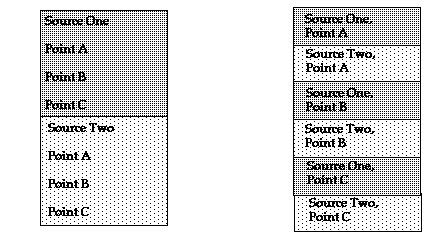In most cases, it is better to compare the two sources you are discussing point by point, rather than first saying everything you want to about the first source, and then saying everything you want to about the second source.
This is because the reader is less likely to make connections between points that are far apart. In other words, if you discuss all of the first source first, your readers will forget Point A of Source One, as they read Points B and C. So when you go on to compare Point A of Source Two to it, the readers, who are not as familiar with the subject as you, the writer, will no longer recall the points you made earlier.
|
A Weak Comparison: |
A Strong Comparison: |

Now the above picture makes comparison seem simpler than it actually is. In fact, you can't just jump from source to source and point to point like a child playing hopscotch. Rather, you need to provide good transitions from source to source and point to point, so that your reader does not get lost and lose track of what you are talking about.
Another tip in writing comparisons is not to overlook the differences between the things you are comparing. Just because the two things are similar doesn't mean you can't also identify some differences between them. If there were no differences between them, they'd be identical! In fact, it is often the differences that make the comparison interesting. In fact, you may want to think about including some of them in the thesis of your paper.
For an example of how to use transitions effectively in a comparison, see the LIT 200 sample paper on What Dreams May Come.